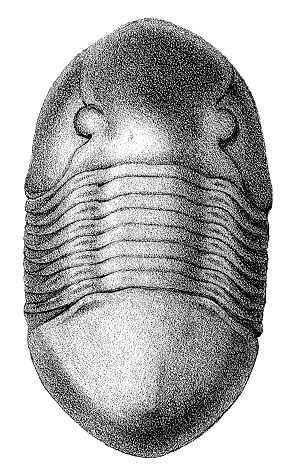PETROGRAPHY OF THE TRENTON AND BLACK RIVER GROUP CARBONATE ROCKS IN THE APPALACHIAN BASIN
FIGURES AND APPENDICIES:
Appendix 5 Figure Captions.
(Click on thumbnail image for an expanded view.)
Dolomite porosity in the Trenton and Black River Formations.
- Figure A5-1. Macroporosity in dolograinstone from northwestern
Ohio.
-

|
A. Small and medium vugs in dolostone
from the Trenton Formation. The rock's depositional texture is not
recognizable, but its origin as a crinoidal grainstone can be inferred
from adjacent core. OH3267 well core, Auglaize County, 1167.6 ft.
|

|
B. Small and medium vugs in crinoidal
grainstone from the Trenton Formation. Much of this sample's original
depositional texture was obliterated by dolomitization, but mimic
relics of some crinoids can be discerned. Voids in the crinoid lumen
(most likely moldic after calcite dissolution) provided the starting
porosity for subsequent enlargement into vugs. OH 3479, Anderson well,
Hancock Co., OH, 1337.8 ft. |
- Figure A5-2.

|
Thin section photomicrograph of the same crinoidal dolograinstone
shown in Figure A5-1B. Several types of pores are present in the rock
- small to medium vugs, molds, intercrystalline pores, and intracrystalline
voids. Several dolomite textures are evident, including nonplanar saddle
dolomite cement, planar-s to nonplanar-a dolomite, and planar-c dolomite.
|
- Figure A5-3.
-

|
Thin section photomicrograph of the same crinoidal dolograinstone
shown in Figure A5-1B. Porosity developed through dissolution of dolomite
and late-stage calcite cement.
|
- Figure A5-4.
-

|
Thin section photomicrograph of the same crinoidal dolograinstone
shown in Figure A5-1B. Calcite is stained red, and some of the nonplanar
(saddle) dolomite cement appears pink due to partial replacement by calcite.
The vugs formed mostly through the dissolution of calcite, but dolomite
dissolution also contributed to the development of void space.
|
- Figure A5-5.
-

|
A. Thin section photomicrograph of
the same crinoidal dolograinstone shown in Figure A5-1B. Vugs and
molds formed by dissolution of calcite and dolomite. The area outlined
by the yellow box is shown in Figure A5-5B. |

|
B. Residue of calcite remaining after
dissolution created a small vug. |
- Figure A5-6.
-

|
Backscattered SEM image of vuggy pore space in the same
crinoidal dolograinstone shown in Figure A5-1B. Planar-s to nonplanar-a
dolomite and nonplanar (saddle) dolomite surround the void, which also
contains pyrite left after calcite dissolution created the pore.
|
- Figure A5-7.
-

|
SEM image of a small triangular intercrystalline pore space
in the same crinoidal dolograinstone shown in Figure A5-1B.
|
- Figure A5-8.
-

|
SEM image of intercrystalline microporosity lining a small
vug space in the same crinoidal dolograinstone shown in Figure A5-1B.
|
- Figure A5-9.
-

|
Core sample of Black River dolomudstone with recognizable
depositional fabric. The matrix is quite tight, but fracturing, brecciation,
and dissolution created good reservoir porosity. Prudential #1A well (OH3372),
Marion County, OH, 1840 ft.
|
- Figure A5-10.
-

|
Core sample of Black River dolomudstone with recognizable
subtidal depositional texture. The matrix is tight, but both vuggy and
fracture porosity are evident. Nonplanar (saddle) dolomite and late-stage
calcite reduce the porosity in these secondary voids. Gray # 1 well, Steuben
County, NY, 7800 ft.
|
- Figures A5-11 and A5-12.
-


|
Thin section photomicrographs of the dolomudstone shown
in Figure A5-10. |
- Figure A5-13.
-

|
Backscattered SEM image of the dolomudstone shown
in Figure A5-10. Vuggy porosity developed through dissolution of nonplanar-s
to nonplanar-a dolomite groundmass, but nonplanar (saddle) dolomite
later reduced this secondary mesoporosity. |
- Figure A5-14 and A5-15.
-


|
SEM views of nonplanar (saddle) dolomite reducing vuggy
pore space dolomudstone shown in Figure A5-10.. Bitumen stains the
crystals in both photomicrographs. |
- Figure A5-16.
-

|
Good mesoporosity and macroporosity development in bioturbated
dolomudstone, Whiteman #1 well, Chemung County, NY, 9529.3 ft. The matrix
is tight, but molds and small to medium vugs formed through dissolution.
Nonplanar (saddle) dolomite partially fills the vugs and molds.
|
- Figure A5-17.
-

|
Close up view of nonplanar (saddle) dolomite partially
filling a medium vug in the same sample shown in Figure A5-16.
|
- Figure A5-18.
-

|
Thin section photomicrograph of the nonplanar (saddle)
dolomite partially filling vugs in the same sample shown in Figure A5-16.
|
- Figures A5-19 and A5-20.
-


|
SEM photographs of nonplanar (saddle) dolomite partially
filling vugs in the same sample shown in Figure A5-16.
|
- Figure A5-21.
-

|
Zebra and breccia fabric in dolomudstone in pay zone of
the Whiteman #1well, Chemung County, NY, 9531 ft.
|
- Figure A5-22.
-

|
Thin section photomicrograph of medium vug in the same
core sample shown in Figure A5-21. Nonplanar (saddle) dolomite cement
partially fills the void space.
|
- Figures A5-23 and A5-24.
-


|
Thin section photomicrographs of macroporosity in the same
core sample shown in Figures A5-21 and A5-22. Note the partially dissolved
late-stage calcite crystals (red), and their residue along corroded dolomite
crystal boundaries and in intercrystalline void space.
|
- Figure A5-25.
-

|
This medium vug is in the same core sample shown in Figure
A5-21. The bitumen residue in the vug once lined nonplanar (saddle) dolomite
crystals (see Figure A5-26). It is not clear if the crystals were plucked
during thin section preparation or actually dissolved to create the void
space. Corroded remnants of the dolomite within the void suggest the latter
might be true.
|
- Figure A5-26.
-

|
Backscattered SEM photograph of bitumen coating nonplanar
(saddle) dolomite that partially fills a medium vug in the Black River
Formation (Whiteman #1 well, Chemung County, NY, 9531 ft.).
|
to top
















